Education in Italy – Interview with Dr. Natascia Petringa

In the dynamic world of education, embracing diversity and fostering inclusivity are paramount. We recently sat down with Dr. Natascia Petringa, part of our faculty, to talk about her journey in the field as a scholar and teacher. After over 25 years teaching in international schools, Dr. Petringa brings a unique perspective to the educational landscape, particularly in the realm of multicultural education.
Ciao Natascia! How are you? Thank you for the opportunity to chat with you. Let’s start from your education and research. Tell us a bit about yourself.
Originally from Rome, but educated in the USA, the UK and Canada for my tertiary education, I have been a Middle and High School Science teacher for over 25 years. I have a PhD in Education from the University of Ottawa (Canada) and am especially interested in multicultural and intercultural education, since all of my career has been in international schools.
What is multicultural education? As laypeople, one can have a hard time figuring out what it is really about. Why do you find it interesting? What motivated you to start a career in this field?
Multicultural education is a personal interest of mine which I have developed due to my teaching career in international schools. My own definition of multicultural education is to provide effective teaching for “ALL” students by meeting their linguistic and cognitive needs, as well as respecting and celebrating their cultures, ethnicities, religions, values, and identities. As a science teacher, I very soon came to realize that scientific terminology and theories are complex and highly specialized in nature. Students who are non-native English speakers therefore are in need of more support if they are to master the content. This requires scaffolding and more inclusive teaching strategies.
What are the main challenges that multiculturalism poses to school systems nowadays?
Multicultural education is challenging because teachers need to revisit their traditional ways of teaching and strive to meet a variety of needs in their diverse classrooms. This involves self-assessment, acknowledging one’s own biases, and implementing teaching strategies which are more inclusive. Like in all jobs, it involves “change”, professional development, and a willingness to do what is “best” for the students we teach!
 Going back to the course you teach at Umbra. How does the seminar component of the course specifically address the comparison between the Italian and U.S. educational systems in terms of multicultural education? How is Italy different from the States? How is the practicum component structured?
Going back to the course you teach at Umbra. How does the seminar component of the course specifically address the comparison between the Italian and U.S. educational systems in terms of multicultural education? How is Italy different from the States? How is the practicum component structured?
This course has a seminar and practicum component. Students meet once a week for a ninety minute seminar and then participate in 30 hours of practicum in selected Italian primary and secondary schools based in Perugia. In that role, they collaborate with the English teacher and support him/her in planning relevant activities for their classes. The practicum is a formidable opportunity because Umbra students who come from the USA are able to witness different teaching styles and classroom practices firsthand. We then discuss these experiences in our weekly seminar. Cultural differences in teaching practices and classroom management techniques are highlighted during the seminar, providing for rich contextual educational conversations.
In terms of student engagement and learning outcomes, what are the expected competencies and skills students should acquire by the end of this course, especially in adapting teaching methods to meet the needs of multicultural students?
As has already happened in the United States, given the recent influx of immigration in Italy over the last decades, Italian classrooms have become more diverse. Therefore traditional educational styles need to change in order to meet the growing needs of more diverse students. This course equips Umbra students with educational theories on multicultural education as well as offers concrete teaching strategies on how to instruct diverse students in all subjects and/or disciplines. In the seminars, I focus on scaffolding techniques and inclusive lesson planning design. The practicum allows Umbra students to showcase and share their North American pedagogical strategies as well as observe and learn from those adopted by teachers working in the Italian public school system. This collaborative opportunity is a “win-win” scenario for all!